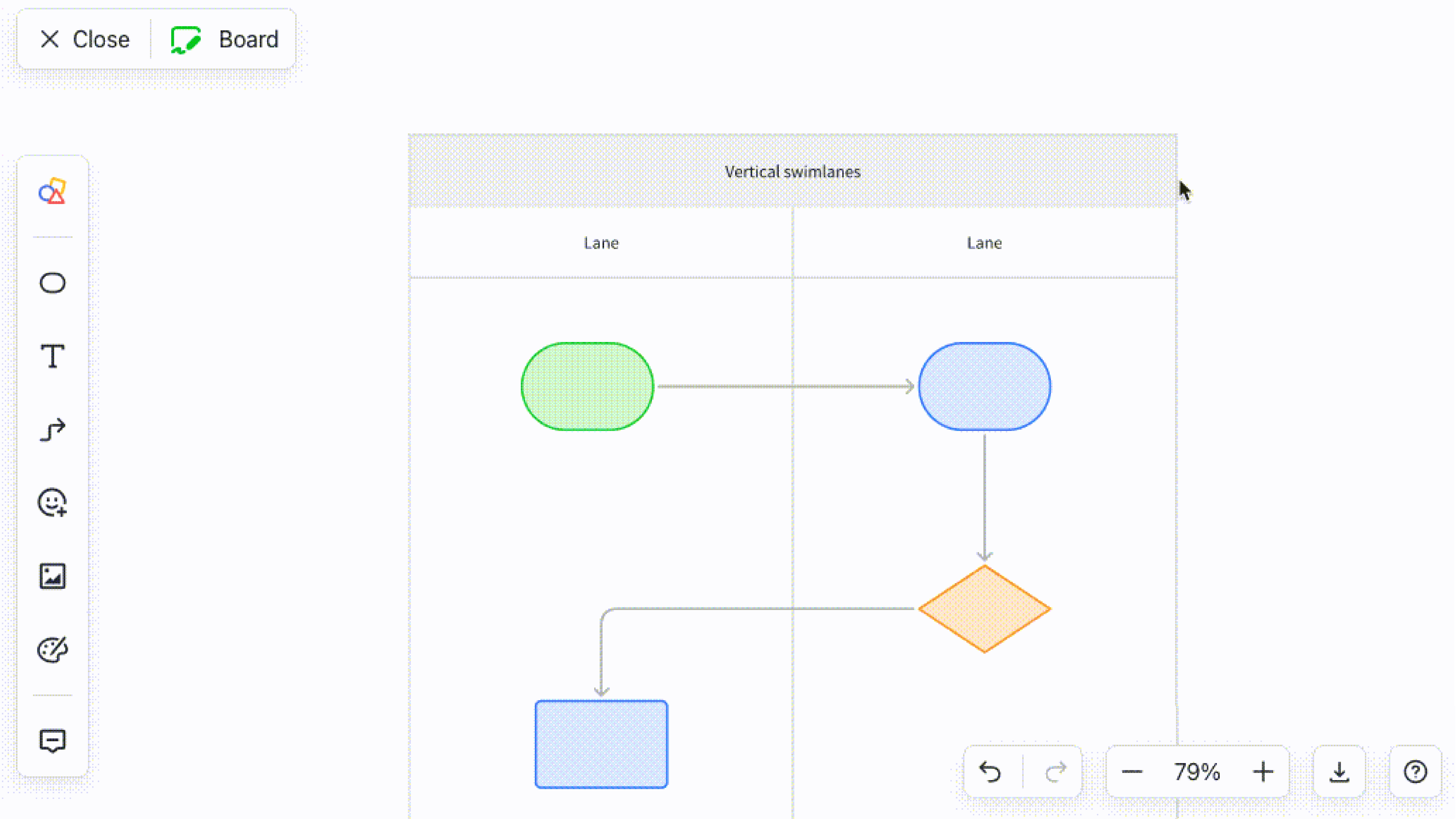Diving into Swimlane Diagrams: Definition and Purpose
Swimlane diagrams, also known as cross-functional flowcharts or simply swimlanes, are a visual representation of a business process that helps to clearly define roles and responsibilities. These diagrams divide a process into separate "lanes," each representing a different department, team, or individual involved in the process. By providing a clear visual representation of the workflow, swimlane diagrams make it easier to understand and analyze complex business processes.
The primary purpose of swimlane diagrams is to improve process management by clarifying the roles and responsibilities of each participant in the process. This ensures that everyone involved in the process understands their specific tasks and responsibilities, leading to better communication, collaboration, and ultimately, improved efficiency.
Exploring the Different Types of Swimlane Diagrams
Swimlane diagrams can be categorized into three main types: horizontal swimlane diagrams, vertical swimlane diagrams, and cross-functional flowcharts. Each type serves a similar purpose but presents the information in a slightly different format.
Horizontal Swimlane Diagrams: In horizontal swimlane diagrams, the lanes are arranged horizontally, running from left to right. Each lane represents a different department, team, or individual involved in the process. The process steps flow from left to right, with arrows indicating the direction of the workflow.
Vertical Swimlane Diagrams: Vertical swimlane diagrams are similar to horizontal swimlane diagrams but with the lanes arranged vertically, running from top to bottom. Each lane represents a different department, team, or individual involved in the process. The process steps flow from top to bottom, with arrows indicating the direction of the workflow.
Cross-Functional Flowcharts: Cross-functional flowcharts combine elements of both horizontal and vertical swimlane diagrams. In these diagrams, the lanes can be arranged both horizontally and vertically, allowing for a more flexible representation of the process. This type of diagram is particularly useful for illustrating complex processes that involve multiple departments or teams working together.
Reaping the Benefits of Swimlane Diagrams
There are several key benefits to using swimlane diagrams in your business process management efforts. These include:
Improved Process Visualization: Swimlane diagrams provide a clear visual representation of a process, making it easier to understand and analyze. This can help identify bottlenecks, redundancies, and inefficiencies, leading to improved process performance.
Clearer Responsibilities and Roles: By dividing a process into separate lanes, swimlane diagrams help to clarify the roles and responsibilities of each participant in the process. This ensures that everyone involved understands their specific tasks and responsibilities, leading to better communication and collaboration.
Enhanced Communication and Collaboration: Swimlane diagrams facilitate communication and collaboration among team members by providing a shared visual language for discussing and analyzing the process. This can lead to improved decision-making and problem-solving.
Simplified Complex Processes: Swimlane diagrams can help break down complex processes into manageable components, making them easier to understand and manage. This can ultimately lead to improved process efficiency and effectiveness.
Choosing the Right Swimlane Diagram Tool: Key Factors to Consider
When selecting a swimlane diagram tool for your organization, there are several factors to consider. These include:
Ease of Use: Look for a tool that is user-friendly and easy to learn, so that your team can quickly start creating and using swimlane diagrams to improve your business processes.
Collaboration Features: Choose a tool that supports real-time collaboration, allowing multiple team members to work on a swimlane diagram simultaneously. This can help foster communication and collaboration within your organization.
Customization Options: Select a tool that offers a variety of customization options, such as different shapes, colors, and line styles, so that you can create swimlane diagrams that accurately represent your organization's unique processes.
Integration with Other Tools: Consider a swimlane diagram tool that integrates with other business process management tools, such as project management or workflow automation software. This can help streamline your organization's processes and improve overall efficiency.
Pricing: Finally, consider the cost of the swimlane diagram tool. Look for a solution that offers a balance between features and affordability, so that you can get the most value for your investment.
Introducing Lark: The Ultimate Swimlane Diagram Solution
Lark is an all-in-one collaboration platform that offers an impressive range of features, including the ability to create and customize swimlane diagrams with ease. In the following sections, we'll explore the benefits of using Lark's swimlane diagrams, discuss some best use cases, and provide a step-by-step guide on how to create and customize your own swimlane diagrams using Lark. Plus, we'll answer some frequently asked questions to help you get the most out of this powerful tool. Let's dive in!

The Benefits of Using Lark's Swimlane Diagrams
Swimlane diagrams are an excellent way to visualize complex processes and workflows, making it easier for teams to understand and collaborate on projects. Lark offers a user-friendly interface and a range of customization options to help you create swimlane diagrams that are tailored to your needs. Some of the key benefits of using Lark's swimlane diagrams include:
Easy to create and edit: With Lark, you can quickly insert a swimlane diagram into your board and start designing your flowchart from scratch, or use a template to get started even faster. The intuitive interface allows you to add, delete, and reorder lanes, set content styles, merge cells, and more with just a few clicks.
Improved team collaboration: Lark's swimlane diagrams make it easy for teams to collaborate on complex processes and workflows. Team members can add comments, share ideas, and make real-time updates to the diagram, ensuring that everyone stays on the same page.
Customizable to your needs: Lark offers a range of customization options for your swimlane diagrams, including vertical and horizontal swimlanes, different shape and icon options, and the ability to adjust row heights and column widths. You can also change the text, border, and fill colors to make your diagram visually appealing and easy to understand.
Best Use Cases for Lark's Swimlane Diagrams
Swimlane diagrams are versatile tools that can be used in a variety of situations to help simplify complex processes and workflows. Some of the best use cases for Lark's swimlane diagrams include:
Project management: Swimlane diagrams are an excellent way to visualize the different stages of a project and the tasks and responsibilities assigned to each team member. This helps to ensure that everyone is clear on their role and can collaborate effectively to complete the project on time and within budget.
Business process modeling: Swimlane diagrams can be used to map out and analyze complex business processes, making it easier to identify areas for improvement and streamline operations.
Software development: Swimlane diagrams can be used to visualize the various stages of a software development process, helping developers to stay organized and on track throughout the project.
Customer journey mapping: Swimlane diagrams can be used to map out the different touchpoints and interactions that customers have with your business, helping you to identify areas for improvement and optimize the overall customer experience.
How to Create and Customize Lark's Swimlane Diagrams: A Step-by-Step Guide
Creating a swimlane diagram in Lark is simple and straightforward. Follow these steps to create and customize your own swimlane diagram:
Insert a swimlane diagram: To get started, hover over the board and click Edit. Then, click the Shapes icon in the left toolbar and select either the Vertical swimlane icon or the Horizontal swimlane icon.

Add shapes to the diagram: Click the Shapes icon in the left toolbar and select a shape to add to your swimlane diagram. Move the shape to the desired swimlane, using the blue dotted lines that appear to help you align it with the lane borders or center.
Add a title to the diagram: To add a title to your swimlane diagram, select the diagram and click the "Name the swimlanes" icon on the floating toolbar.
Move and resize the diagram: To move the diagram, click on the title or a blank space in the diagram and drag it. To resize the diagram, click on a corner and drag to adjust the size.
Edit and customize the diagram: Lark offers a range of customization options for your swimlane diagrams, including editing cells, merging and unmerging cells, inserting rows and columns, changing row and column order, and adjusting row heights and column widths. You can also add content such as icons, images, and links to the diagram.
Frequently Asked Questions About Lark's Swimlane Diagrams
Q: Can I duplicate a swimlane diagram in Lark?
A: Yes, to duplicate a swimlane diagram, select the diagram and click the "more" icon (···) in the floating toolbar. Then, select "Make a Copy" or press Cmd + D (macOS) or Ctrl + D (Windows).
Q: How do I delete a swimlane diagram in Lark?
A: To delete a swimlane diagram, select the diagram and click the "more" icon (···) in the floating toolbar. Then, select "Delete" or press the Delete key on your keyboard. Note that any content linked to the diagram will also be deleted.
Q: Can I collaborate with my team on a swimlane diagram in Lark?
A: Yes, Lark makes it easy for teams to collaborate on swimlane diagrams in real-time. Team members can add comments, share ideas, and make updates to the diagram to ensure everyone stays on the same page.
In conclusion, Lark's swimlane diagrams are a powerful and versatile tool that can help you visualize complex processes and workflows, improve team collaboration, and streamline operations. With the step-by-step guide and frequently asked questions provided in this blog post, you should now be well-equipped to create and customize your own swimlane diagrams using Lark. Happy diagramming!
Table of Contents








